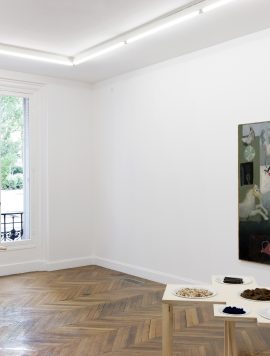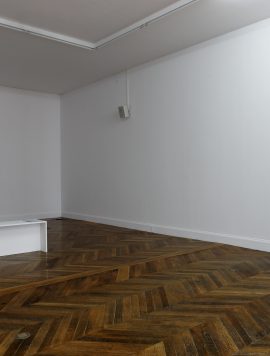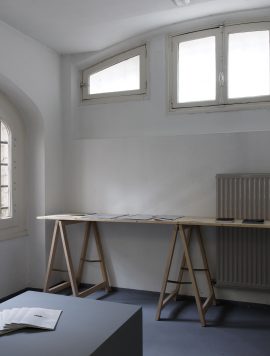Maps, timelines, radio programmes
The project “Outre mesures et programmes radio (Maps, timelines, radio programmes)” does not present itself as detached from the time and events surrounding its making. The selection of artworks had almost been finalized when revolutions flared across the Arab world, irrevocably changing interpretations: from works questioning the delay in a longoverdue revolution they were transformed into signs of a determined movement that would lead to it.
Whenever I tried to distance myself from the political context and relations present in my life and work, the political continued to return unexpectedly, irresistibly imposing itself on my thoughts and production. As such, my work has been a continuous investigation of the position of individuals in a politically driven world. If the current revolutions have changed my ideas in any way, they have at the very least led me to revisit my past decisions and reconsider the times when, under a false impression of helplessness, I gave up too early on ambitious beliefs. During these times, we encounter, nonetheless, artists who have had the courage to investigate their contexts, and produce projects that look into their state of being. Their output is enriched by activism, references and current events, emerging as forms from a given period that share the artists’ point of view with the viewer, while at the same time giving an abstract dimension to the situations being explored. Here art becomes a tool for movement and activism, research and documentation, commentary and representation.
“Outre mesures et programmes radio (Maps, timelines, radio programmes)” is a two-part deliberation on the apprehensive construction of history. Such basic tools of interpretation as maps and personal timelines have been reinvented by the participating artists to reference a state or take the pulse of a perpetually changing societal body. The first part of this project is an exhibition showing artworks that explore individual positions within the broader setting and construct specific narratives within general and mutating social, economic and political contexts. While collective history is unmade and rewritten with shapes imposed and disfigurements tolerated, personal narratives are inherited, lent and borrowed across epochs and generations.
In her studies of literary and film productions that imagine the future, Maha Maamoun proposes different relationships between the individual/collective and their setting, the Pyramids – a symbol for Egypt, its Ruler, its People, its Glory and its Struggle for Survival. Mohssin Harraki, on the other hand, tracks linear accessions to power and illustrates, through the form of the family tree, chronological political narratives. Within the branches of these trees, time is at once tangible and intangible, a state of flux that conjures up a work-in-progress moving between the artist’s studio and the exhibition space. By illustrating individual implication in an authority’s rise to power Ossama Mohammed’s film, made in 1979, defies the myth of the limited role of the individual in collective submission.
Sound artist Tarek Atoui scans and combines at high speed tracks from a library of tens of thousands of audio microsamples of compositions by deceased musicians. Atoui constructs bridges across time through a program that uses mathematical serial algorithms and a system of pressure sensors that engage the physical strength of the artist’s body. As it moves about the exhibition space, Otobong Nkanga’s work investigates the different roles and usages of materials known to her from her hometown and rediscovered within other contexts. The late Hassan Soliman, whose work is rarely shown in contemporary exhibitions, temporarily took refuge in abstraction following the Arab defeat in the 1967 war. He worked for long years on individual paintings, adding elements to them over time that resonated with the ongoing events in his life.
In 1968, Hassan Soliman captured the central questions explored in this exhibition project when he wrote: “Art expresses the tension between past and present but does not separate the two. It is not an entity that has constant limits. It is a manifestation both of the past as it awakens and of the unborn future… Is there any art that articulates our present and our future, while remaining linked to our past? What is so-called Revolutionary Art? And what art can provide promise of a society that will prosper?” For this exhibition project, Cevdet Erek proposes a unique new time ruler that is not only a reflection on the past but also an attempt to dream of the future. As we move through time, slowly advancing from left to right along the mass-produced Ruler Near, the ruler becomes a project of/on the past.
Ala Younis
Translated by Marjolaine Calipel
around the exhibition
-
21/05/2011
From 8:00 to 9:00 pm
Concert performance by Tarek Atoui during the opening. -
28/05/2011
From 4:00 to 5:30 pm
Off-site: round table with the artists of the exhibition moderated by the curator, Ala Younis, at Bétonsalon, Paris. -
18/06/2011
From 6:00 to 7:00 pm
Two-voices guided tour by Ala Younis and Marianne Lanavère, La Galerie’s director. -
25/06/2011
From 4:00 to 5:00 pm
Radio workshop around the exhibition with Ala Younis and the artist, Otonbong Nkanga (in Arabic and French). -
09/07/2011
From 4:00 to 5:30 pm
Radio workshop.




